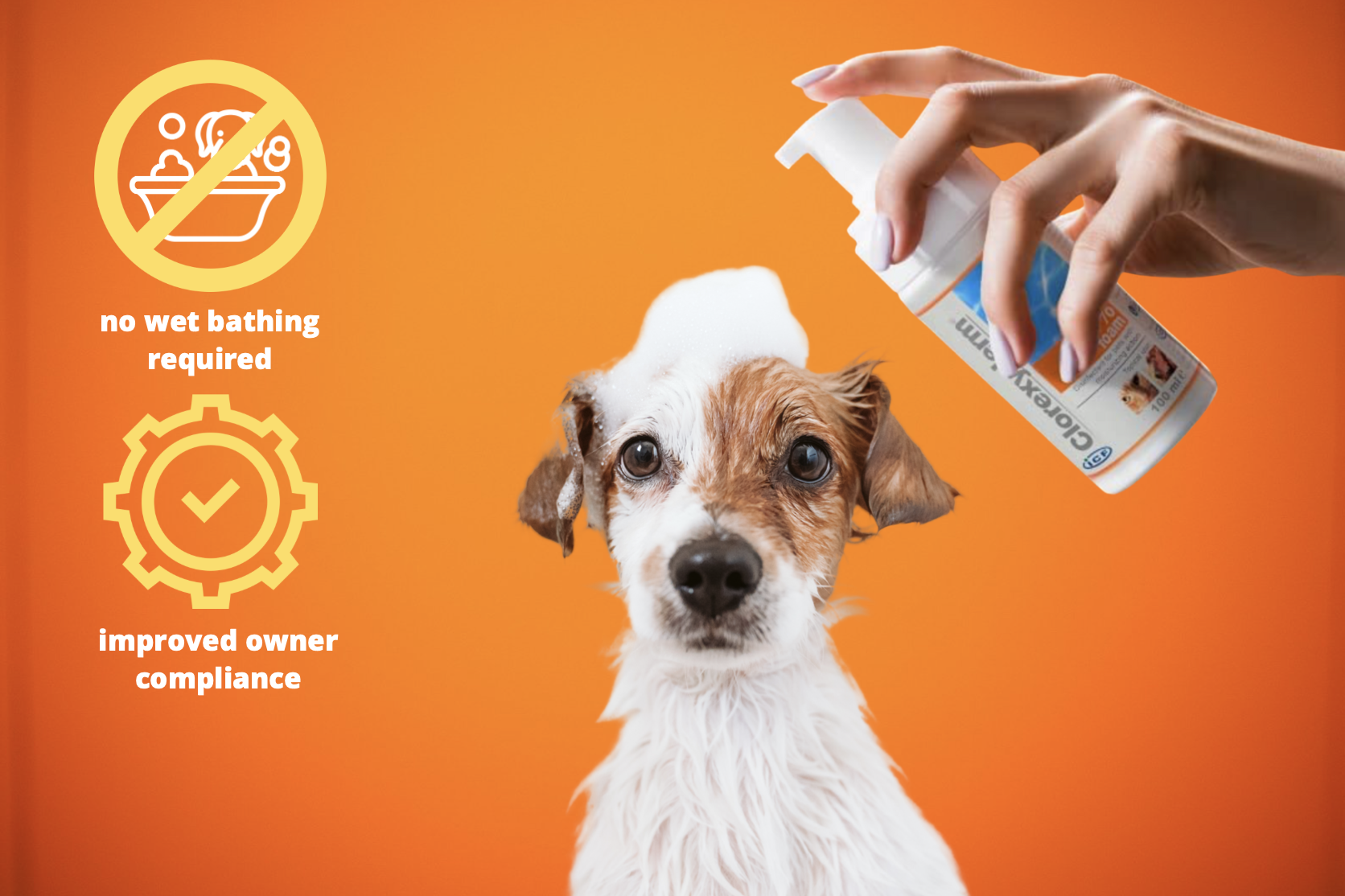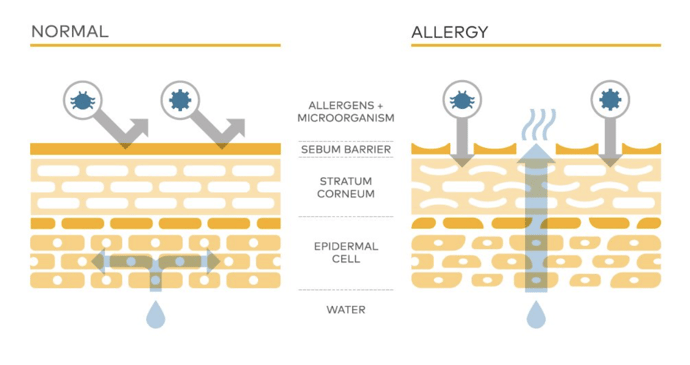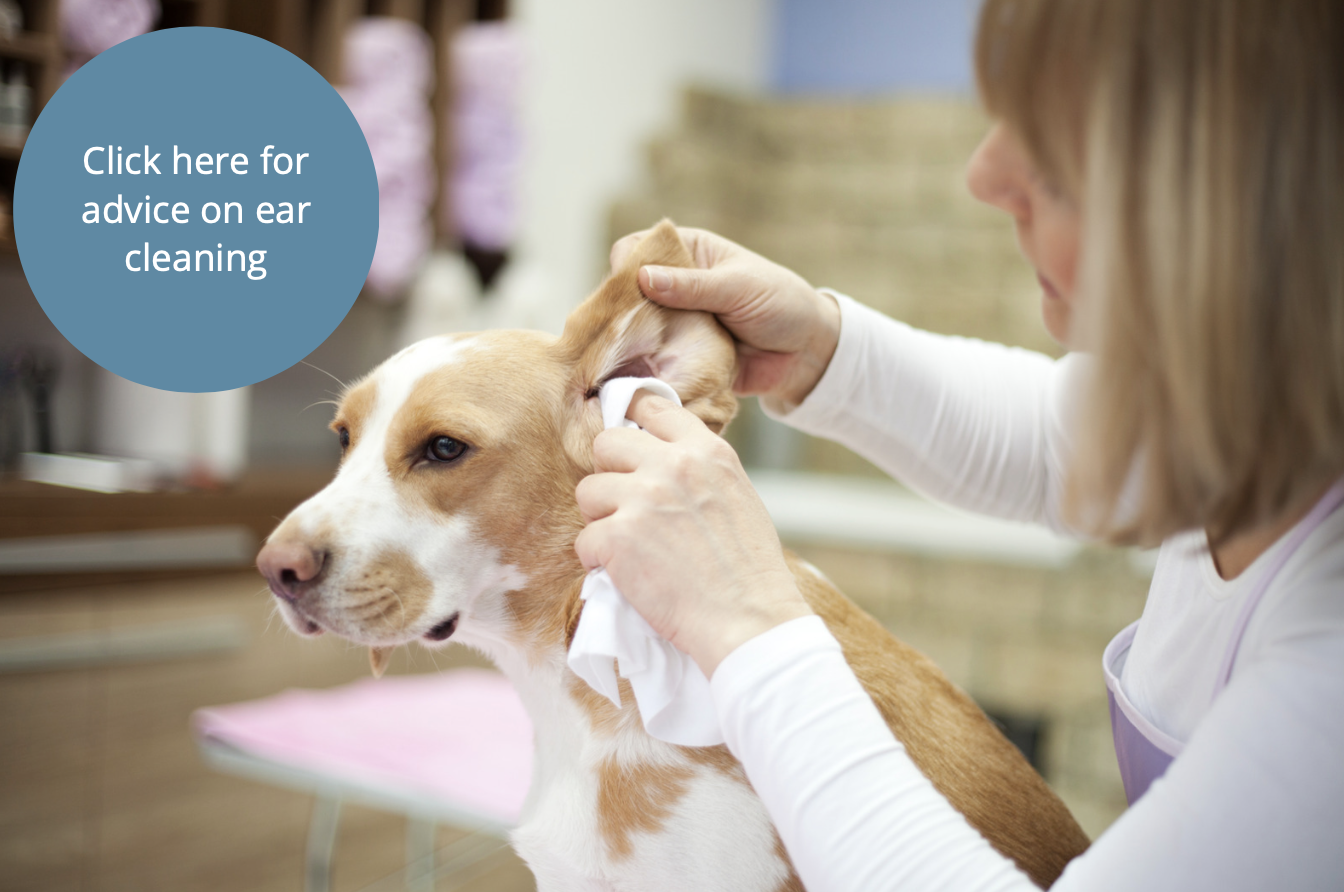Can my pet's allergy be cured?
Unfortunately, there is no magic cure for allergy. Often, the goal is not to cure the disease, but to manage the symptoms so that the quality of life for your pet is not impacted to such a degree that they suffer. This can be best achieved through a multi-modal treatment approach which involves combining different treatment options.
Managing allergy can be achieved through:
- Regular flea treatment
- Itch blocking medication
- Topical therapy applied directly to the skin
- Ear cleaners and flushes that promote long-term ear health
- Essential Fatty Acids to strengthen skin barrier function
- A low allergen diet
- Environmental sprays to reduce dust exposure
- Immunotherapy

Topical Therapy
When your pet suffers, it affects the whole family. The good news is that allergy can be treated and your pet's symptoms managed.
Topical therapy is a very useful to way to help manage a variety of the symptoms associated with allergy. In most cases where the skin is directly affected by allergy, topical therapy can help resolve symptoms such as bacterial or fungal overgrowth and reddened skin. In most cases of bacterial or fungal overgrowth, topical therapy is the primary treatment choice for such problems and antibiotics are not recommended.
Symptoms such as itching, poor skin barrier function and bacterial / fungal skin and ear issues can be managed with:
- Shampoos
- Sprays & Foams
- Gels
- Wipes
- Spot-On Treatments
- Ear Cleaners
Shampoo Therapy
Shampoo therapy is an effective way of managing allergic skin. Shampooing pets with allergy can help remove allergens such as pollen and dust off of the coat. Some shampoos are also specially formulated to help target bacteria and yeast that cause skin infections, whilst others contain ingredients that can help soothe and moisturise itchy skin.
Antibacterial / Anti Fungal Shampoos
Allergic pets have an imbalance of harmful microflora on their skin and this makes them more prone to developing skin infections. Itching can cause excess licking and scratching which can also cause infections.
For many allergic dogs, good skin hygiene through the routine use of medicated topical antiseptic products, is another key part of achieving long-term control. Shampoos containing chlorhexidine are an effective way of managing the overgrowth of bacteria and yeast. Used regularly they can help restore a healthy balance of skin microflora.
Soothing Shampoos
If your dog is allergic to pollens and dust, shampooing the coat regularly can help wash allergens and other irritants off of the skin. Using a soothing shampoo that contains emollient ingredients such as lanolin and betaine is an excellent way of removing allergens. They also help soothe and moisturise itchy, red and irritated skin.
Allergic animals also have a defective skin barrier which leads to dry skin. Shampoos that moisturise the skin can help strengthen and restore the skin barrier which can help reduce symptoms associated with allergy.
For more information on Ermidra, our dermatologist recommended soothing shampoo, watch the video below.
Foams & Sprays
To help manage your pet's allergy effectively, it is important that you can apply the recommended treatment properly. Although shampooing allergic pets is recommended, it may be difficult or impractical to wet bathe your pet.
Luckily, many of the antibacterial / anti fungal and soothing shampoos are also available as easy-to-use foams or sprays.
These are leave-on preparations that require no water and are ideal for localised skin areas where perhaps a full bath may not be necessary. They can also be applied daily in-between wet baths as daily management of the skin will result in a quicker resolution of the problem.
Owner compliance, a key factor in successful treatment outcomes, is much easier when using foams and sprays.

Medicated Wipes
Many allergic dogs lick their paws which can cause secondary bacterial and fungal issues in between the digits. Excessive licking can also cause unsightly saliva staining on the fur around the feet. Some breeds of dog with skin and facial folds are also prone to getting secondary issues on the skin between the folds as they are warm and moist, a perfect breeding ground for micro-organisms.
Using a medicated wipe to regularly clean the paws and the skin folds is an excellent way of keeping the skin in these areas healthy. Wipes are easy to use and can be applied daily or as frequently as needed to maintain healthy skin.
For more information on CLX Wipes, our dermatologist recommended medicated wipes view the video below:
Skin Gels
Topical skin gels are a great way to manage localised problems on the skin. They are are particularly useful when applied to areas of skin such as the paws, lips and chin.
Skin gels are specially formulated to work against bacteria and yeast and have a long lasting soothing effect on the skin. An added benefit is that they can create a protective film on the surface of the skin, which can help reduce contamination from licking and other irritants like dust and pollen.
For information on Clorexyderm Spot Gel watch the video below:
Spot-On Therapy
Another way to help reduce the symptoms of allergy and something that can be used alongside shampoos etc is Spot-On therapy.
These are specially formulated solutions that can be applied weekly onto a small area of skin. Containing natural essential oils and essential fatty acids, Spot-On treatments are a great way of promoting long-term skin health and they can help control skin microflora, restore skin barrier function and reduce itching.
Used alongside shampoo therapy they may help reduce the frequency of baths and can reduce the number of skin flare ups through the year. They are a great option on their own if applying other forms of topical therapy is particularly difficult.

Ear Cleaners
Many allergic dogs suffer with ear infections. In fact, in many allergic patients, the only symptom of their allergy is recurrent bacterial or fungal ear disease. This is because allergy causes inflammation of the ear canal and increased heat in the ear helps provide the perfect environment for bacteria and yeast to overgrow.
If your pet has a history of recurrent ear problems or has been given medicated ear drops to treat an infection, the best way to help resolve the problem quickly and then to ensure long term ear health, is to use an antiseptic ear cleaner that can potentiate medicated drops.
Using an antiseptic cleanser before application of medicated drops and then 1-2 times per week ongoing once the infection is resolved, is a great way of keeping ears clean and stopping bacteria and yeast from causing ear disease.
If your dog suffers with recurrent ear problems click on the video below to find out more on Otodine, our dermatologist recommended pre-treatment and maintenance cleaner for dogs with bacterial ear problems:
If your dog suffers with ongoing yeast problems in their ears or goes swimming, click on the video below to find out more about Clorexyderm Oto, our anti fungal maintenance cleaner that can help maintain good ear hygiene:
If your dog or cat gets excessively waxy ears, regular cleaning is a great way to help keep them healthy and to stop the development of ear problems. Click on the video below to find out more about Otoact, our dermatologist recommended wax removing and soothing ear cleaner that can help keep ears clean:
Antibiotics for Ear Problems: Are they always necessary?
If your pet gets recurrent ear issues, you may find yourself often going to the vet and being prescribed antibiotic drops. These drops also usually contain an anti-fungal to kill yeast and a steroid to reduce inflammation. In more serious ear problems, these drops are necessary to resolve the problem. However, due to the increase in antibiotic resistance, overuse and misuse of antibiotics is a serious concern that sometimes causes these drops to be ineffective. Since these drugs are a precious resource in the fight against many infections, your vet is guided by regulatory bodies to use them sparingly and only in cases that require them.
If your vet prescribes antibiotics it is essential you use them for the duration recommended. Stopping early after a few days and then starting again when the ear flares up encourages antibiotic resistance and can make your pet susceptible to more serious ear problems that may be harder to treat. Always follow your vets advice on using antibiotics.
Due to concerns about antibiotic resistance, your vet may sometimes decide that antibiotics are not necessary. In milder ear cases where perhaps the overgrowth of bacteria and yeast is mild or moderate, or perhaps where there is only yeast present but no bacteria, it may be more sensible to use antiseptic based products to help reduce microbial overgrowth. If the ear problem is caught early enough and a treatment plan initiated quickly, an antiseptic approach can often be as effective as a course of antibiotics.
Thanks to new scientific innovations, products which work in a similar way to antibiotic drops but which do not cause antibiotic resistance are now available. These may be used in preference to antibiotics in cases where antibiotics perhaps are not required.
Your vet will be able to investigate the extent of your pet's ear problem and advise on appropriate therapy.
One product that may be recommended by your vet is Peptivet Ear Drops or Oto Gel. Watch the video below to learn more about our Peptivet ear range and how it may be used to help manage ears prone to allergic symptoms:
Allergen Avoidance:
80% of allergic pet's have an allergy to house dust mites.
Although house dust cannot be completely removed, there are things that can be done to help reduce the amount of dust in the environment.
Regular vacuuming of the home, especially areas your pet frequents often, along with regular washing of your pet's bedding can help reduce exposure to house dust.
There are also environmental sprays that can help bind and coat dust particles, meaning they cannot interact with your pet's skin in such a way as to cause an allergic reaction.
It is important to remember that although insecticidal sprays that kill dust mites are useful, animals are actually allergic to the dust mite faeces and proteins on the body of the mite, so although the dust mites may be dead, your pet can still be allergic to the faeces in the environment and the mite bodies.
To learn more about Allergone, our environmental spray to help reduce exposure to house dust view the video below:
The importance of balanced, healthy skin:
The topical treatment options detailed above can play an important role in helping to alleviate your pet's allergy symptoms. Shampoos and ear cleaners can help by cleansing the skin and ears whilst helping to control bacteria and yeast on the skin that can cause itching and secondary infections.
Allergic pet's are known to have differences in the make-up and structure of their skin compared to animals that do not suffer with allergy. These differences affect the quality of the skin barrier and also the richness of the skin microbiome.
Let's look at the role each one of these plays in allergy.
Skin Barrier Function
The skin barrier is the outermost layer of the skin. Amongst other things, it plays an important role in locking in moisture and keeping allergens, viruses and bacteria out. Humans often use moisturisers to help maintain healthy skin, and in some dogs this is just as important.
Allergic animals are known to have a defective skin barrier meaning they are more prone to dry skin and secondary skin infections. Many of the symptoms associated with allergy such as itchy, dry, reddened skin and skin infections are directly related to poor skin barrier function.
Supporting the skin barrier in allergic animals is critical to managing the symptoms and reducing the number of skin flare ups.
There are different ways to support the skin barrier; topical products that can be applied to the skin via sprays and spot-on's, special foods or oral supplements. They all contain ingredients that aid the health of the skin, for example, essential fatty acids such as omega 3 and omega 6 and moisturising emollients.
Although skin barrier support products alone are unlikely to be sufficient to control the symptoms of skin allergies, they can play a key part in the successful long-term management when used in combination with other treatments.

Essential Fatty Acid Supplementation
One way to help restore and strengthen the skin barrier is by supplementing your pet's diet with Essential Fatty Acids or EFA's.
Omega 6 and Omega 3 fatty acids are essential for optimal skin health. However, dogs and cats are unable to produce these fatty acids themselves, so supplementing them by way of oral supplements or topical skin products is a great way to maintain proper skin health and function. Without them, skin is more prone to drying and inflammation, two of the most common symptoms of allergy.
EFA's are responsible for helping to maintain a strong and healthy skin barrier, locking in moisture and keeping out allergens and harmful organisms. Think of EFA's as the mortar that helps keep the brick wall-like structure of the skin together!
It is important to get the balance of Omega 3 & 6 right. Omega 3 has been found to play an important role in modulating inflammation and clinical studies have proven the importance of EFA's in helping to manage the symptoms of allergy when used in conjunction with other therapies.
Watch the video below to learn more about Atopi-3, our oral EFA supplement for dogs and cats:
The Skin Microbiome:
The skin contains a microbiome of billions of microorganisms that work in symbiosis to keep the skin healthy.
In healthy animals, this microbiome is rich and diverse and a delicate balance between healthy bacteria and potentially harmful bacteria in favour of the good bacteria, means they are free from allergy and rarely suffer with skin issues. In allergic animals, there is a dysbiosis of the skin microbiome whereby they have a less rich microbiome and one that is made up of more potentially harmful bacteria. This directly affects skin barrier function increasing their likelihood of being allergic and also makes them more prone to secondary skin infections.
There is also evidence that shows the gut microbiome (organisms that live within the gut) can directly affect skin health. This is called the gut-skin axis and dysbiosis in the gut microbiome directly affects the immune response which promotes the development of skin diseases such as atopic dermatitis.
Imbalances in the skin and gut microbiome that may affect the development and severity of symptoms can be addressed with oral and topical pre and probiotics. By addressing the microbiomes of the skin and gut directly, allergic symptoms may be reduced.
Linkskin Spray and Tablets are formulated with pre and probiotics to help restore a healthy skin and gut microbiome. Watch the video below to learn more about Linkskin Spray and Tablets.
Downloads
Click on the link below to download our useful guides:
Any Questions?

Site map Privacy police Terms of use
All trademarks are property of Nextmune Animal Health or a related company or a licensor unless otherwise noted.
@2022 Nextmune UK Ltd. All rights reserved.

